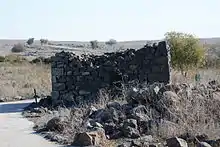Deir Qeruh
Deir Qeruh, (Arabic: دير قروح "Monastery of Qeruḥ"), is a ruined Byzantine-period village in the Golan Heights, located within an Israeli national park, the Gamla nature reserve.[1]
.JPG.webp)
The village was located near Gamla, a much older fortified town.[1] Deir Qeruh was founded in the 4th century CE, and a church and monastery were built there in the 6th century.[2] The village was abandoned in the mid-7th century following the Arab conquest, and inhabited again during the 13th and 14th centuries, in the Mamluk period.[3][2] A modern Syrian village rose at the site in the 20th century, and was again abandoned after the 1967 Six-Day War, when it came under Israeli control.[3]
Monastery and Church of St George
The north-eastern part of the village is the best preserved, and includes a monastery centered around a church,[1] founded in the 6th century and dedicated to St George, who is mentioned on the lintel at the church entrance.[2] The church has a square apse - a feature known from ancient Syria and Jordan, but not present in churches west of the Jordan River.[4] After the abandonment of Deir Qeruh in the seventh century and the later resettlement of the site, the monastic complex was used for other purposes.[2]

External links
- Deir Qeruḥ at Creighton University website: 360° photos with 3D option (taken in 2006), interactive plan of the monastery, short explanatory text. Accessed July 2018.
- Photos of village ruins
- Photo of the church interior: the north aisle and its side door; from south aisle
Bibliography
- Ma'oz, Zvi Uri: Deir Qeruh, 1983, in "Hadashot Arkheologiyot - Excavations and Surveys in Israel" 2: 23-25, Israel Antiquities Authority.[5]
- Ma'oz, Zvi Uri: Deir Qeruh, 1993, pp. 348–49 in "The New Encyclopedia of Archaeological Excavations in the Holy Land", 4 volumes, Ephraim Stern (ed.), New York: Simon & Schuster; Jerusalem: Israel Exploration Society & Carta.[5]
References
- Gamla Nature Reserve at the Israel Nature and Parks Authority site. Accessed July 12, 21018.
- Deir Qeruḥ at Creighton University website. Accessed July 2018.
- Explanatory sign of the Israel Nature and Parks Authority
- Jerome Murphy-O'Connor (2008). The Holy Land: An Oxford Archaeological Guide from Earliest Times to 1700. Oxford Archaeological Guides. Oxford: Oxford University Press. pp. 289–290. ISBN 978-0-19-923666-4. Retrieved 12 July 2018.
- Bibliographies for Theology, Kripke Center at Creighton University. Accessed 12 July 2018